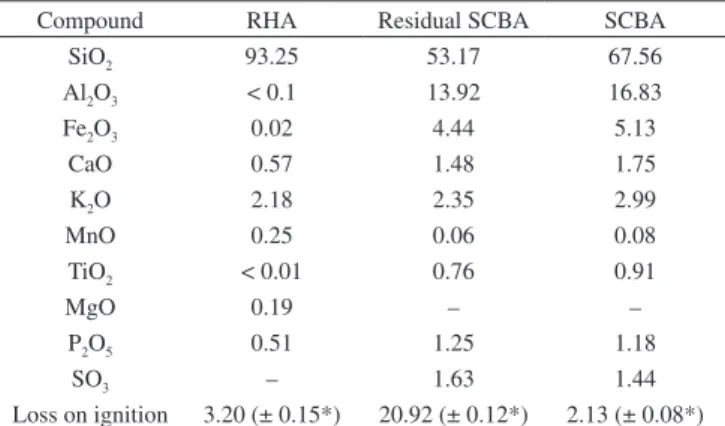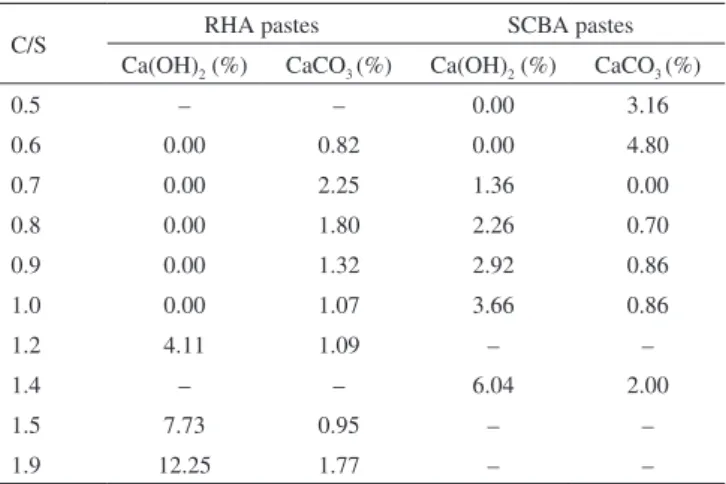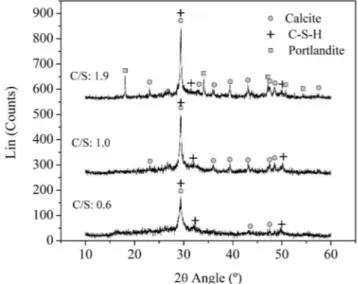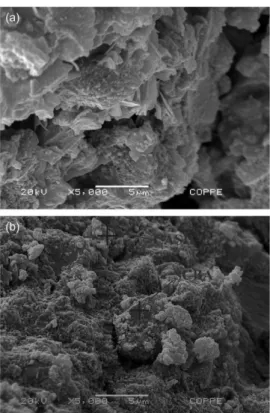Artigo
*e-mail: gcc@uenf.br
INFLUENCE OF INITIAL CaO/SiO2 RATIO ON THE HYDRATION OF RICE HUSK ASH-Ca(OH)2 AND SUGAR
CANE BAGASSE ASH-Ca(OH)2 PASTES
Lourdes Maria Silva de Souzaa,b, Eduardo de Moraes Rego Fairbairnb, Romildo Dias Toledo Filhob and Guilherme Chagas
Cordeiroc,*
aFaculty of Civil Engineering and Geosciences, Delft University Of Technology, Delft, Netherlands
bInstituto Alberto Luiz Coimbra de Pós-Graduação e Pesquisa em Engenharia, Universidade Federal do Rio de Janeiro, 21941-972 Rio de Janeiro – RJ, Brasil
cLaboratório de Engenharia Civil, Universidade Estadual do Norte Fluminense Darcy Ribeiro, 28013-602 Campos dos Goytacazes – RJ, Brasil
Recebido em 13/02/2014; aceito em 18/07/2014; publicado na web em 22/09/2014
This work presents the results of a study on the hydration of pastes containing calcium hydroxide and either rice husk ash (RHA) or sugar cane bagasse ash (SCBA) in various initial CaO/SiO2 molar ratios. The products of the reactions were characterized by thermal analyses X-ray diffraction, and scanning electron microscopy. In the case of the RHA pastes, the product was composed of CaO–SiO2–H2O (type I C-S-H) or CaO–SiO2–H2O (type II C-S-H) according to the CaO/SiO2 ratio of the mixture. In contrast, in the case of the SBCA pastes, the product was composed primarily of CaO–SiO2–H2O that differed from both the previous types; the product also contained inclusions of calcium aluminate hydrates.
Keywords: rice husk ash; sugar cane bagasse ash; hydration.
INTRODUCTION
During the past decades, there has been a growing concern on the use of agricultural by-products, such as rice husk and sugar cane bagasse ashes, as pozzolanic mineral admixtures in cement-based materials. The rice husk ash (RHA) is a high silica content material and its high pozzolanic activity has been recognized since 1970’s.1-4 More recently, the sugar cane bagasse ash (SCBA) has shown to be of great value as pozzolan, improving characteristics such as mechanical strength and durability in concretes.5-7
Both RHA and SCBA affect the performances of paste, mor-tar and concrete due to both physical and pozzolanic effects. The physical effects are primarily associated with their inluence on the packing characteristics of the mixture. On the other hand, the poz-zolanic effects are related with their capability of providing siliceous/ aluminous amorphous compounds that will chemically react with calcium hydroxide (Ca[OH]2 or CH
8 or portlandite) in the presence of water, as described by Equation 1. Investigating the pozzolanic reaction through the Ca(OH)2-pozzolan-water system is a helpful path to the interpretation of the hydration of cementitous materials with pozzolanic addition, since that system is simpler than the cement-pozzolan-water system.9
xSiO2 + yCaO + zH2O →yCaO.xSiO2.zH2O (1) The reaction between RHA, Ca(OH)2 and water has been the subject of study of some researchers.10-15 Since this ash has high silica content, the reaction is well compared with that of silica fume, Ca(OH)2 and water and its main product is known to be CaO-SiO2 -H2O (denominated by C-S-H). Nonetheless, its characterization varies amongst authors. James and Subba Rao10,13 states it is a low CaO/SiO2 molar ratio (C/S ratio) C-S-H much alike the C-S-H (I) described by Taylor,16 whereas Billong et al.14 deines it as being a mixture of C-S-H (I) and C-S-H (II). In contrast, Yu et al.15 defend that the C-S-H formed has deinite stoichiometry of CaO1.5∙SiO3.5∙xH2O.
C-S-H (I) is well known as the product of the reaction between hydrous silica and Ca(OH)2 at ordinary temperatures, with C/S ratios from 0.8 to 1.5.16 In contrast, C-S-H (II) would be the product of the bottle reaction of tricalcium silicate (3CaO•SiO2) with pure water and its C/S ratio varies from 1.5 to 2.0. Nevertheless, C-S-H (II) was also detectable in systems formed by Ca(OH)2, silica fume and water. Indeed, Guindy et al.,17 using X-ray diffraction and thermal analysis, concluded that, whereas C-S-H (I) is the main product in mixtures of low initial C/S ratio, when the ratio was increased, C-S-H (II) could also be seen as product. Abo-El-Enein et al.18 and El-Shimy et al.19 presented similar indings in their work.
In relation to pozzolanic reactions of SCBA, there is little work on the Ca(OH)2-SCBA-water system. Likewise for other pozzolans, the main product of this reaction is stated to be C-S-H.20-23 However, as this system also contains signiicant amount of Al2O3, calcium alumino silicate hydrates (CaO-Al2O3-SiO2-H2O or C-A-S-H) and calcium aluminate hydrate (CaO-Al2O3-H2O or C-A-H) are also expected to be formed.21 Not much has been said on the nature of the C-S-H formed. Frías and Villar-Cociña22 found the product to be mainly amorphous C-S-H of low C/S ratio; however, no attempt of correlation to known products (C-S-H [I] and [II]) was made.
In the present paper, a study on the hydration of the controlled sys-tems RHA- Ca(OH)2-water and SCBA- Ca(OH)2-water is presented. The aim is to evaluate how the origin of the silica in the system and the initial C/S ratio affect the inal products. Detailed measurements of thermal analyses and X-ray diffraction were carried out in order to compare the formed compounds in the different pastes.
EXPERIMENTAL
Materials
the other hand, a raw sugar cane bagasse ash was collected from the boiler during a cleaning operation from a sugar/alcohol plant in the state of Rio de Janeiro, Brazil. The residual SCBA was then burnt in a mufle furnace in two steps: at 350 ºC during 3 hours and at 600 ºC for another 3 hours.25 This burning was made to decrease the high carbon content in the residual ash. Finally, it was dry ground for 8 hours in a rotational ball mill. Chemically pure calcium hydroxide and deionized water were also used in the mixtures.
The particle size distribution of both ashes was measured using a Malvern Mastersizer laser diffraction analyzer with deionized wa-ter as dispersant. The oxide percentages were dewa-termined by X-ray luorescence (XRF) using a Shimadzu EDX 800 spectrometer with Rh tube and the speciic surface area was measured according to the N2 adsorption (B.E.T.) using a Micromeritics Accupic. X-ray diffraction patterns (powder method) were taken using a Bruker D8 Focus diffractometer with Cu-Kα radiation (40 mA; 40 kV; 10° ≤ 2θ≤ 60°; 0.03° step; 1 s couting time).
Methods
Two sets of mixtures were manually prepared, one of RHA and Ca(OH)2 pastes and the other of SCBA and Ca(OH)2 pastes. Firstly, the mixtures were made in order to obtain initial C/S molar ratios varying from 0.6 to 1.0. After some preliminary results, complemen-tary pastes were produced, in order to obtain more comprehensive ranges of C/S values. All analyzed mixtures, and their C/S ratios, are presented in Table 1. The water/solids ratio (in mass) was 1.3 for all mixtures. This value was the minimum ratio in order to produce homogeneous pastes with the materials used in this work. The pastes were cured in sealed plastic ilms in a temperature controlled room at 40 ºC.15 In this paper, the samples were denominated as ASH-CS where ASH stands for RHA or SCBA and CS represents the C/S ratio of the mixture. In that way, the sample of RHA paste with C/S ratio of 0.6 was named RHA-0.6.
The nature of the pozzolanic reaction’s products was investigated by means of thermal analyses (TG, DTG and DTA) performed in a TA Instruments SDT Q 600 thermoanalyser, in inert atmosphere (N2), with maximum low of 100 ml/min and heating rate of 10 ºC/ min, from 25 ºC to 1000 ºC. It was used a platinum crucible with sample weight of approximately 10 mg. Both RHA and SCBA pastes were analyzed at 50 days of curing. The samples were tested without previous drying and all exhibited a large step at the beginning of the TG curve due to their high water content. The unreacted Ca(OH)2 and CaCO3 formed were quantiied based on the mass losses (∆m) related to the decomposition of each compound, according to Equations 1 and 2. It is important to note that the presence of CaCO3 is due to the carbonation of the Ca(OH)2 when in contact with CO2 in the air during experimental procedures.
Ca(OH)2 (%) = 4.11 ∙ ∆mCa(OH)2 (1)
CaCO3 (%) = 2.27 ∙ ∆mCaCO3 (2)
The products of selected C/S pastes were also characterized by X-ray diffraction (XRD). Samples containing RHA were scanned over a 10°-60° 2θ range, while the SCBA- Ca(OH)2 samples were analyzed in a 5°-60° 2θ range in order to investigate the presence of
carboaluminates. The samples RHA-0.5, RHA-1.0, RHA-1.9, SCBA-0.5, SCBA-0.7 and SCBA-1.4 were analyzed after 50 days of curing. In order to study the morphology of the pastes, scanning electron microscope (SEM) images were obtained in a JEOL JSM 6460 LV microscope, operating in 20 kV and working distance of about 10 mm. The microscope was equipped with an energy dispersive x-ray spectrometer (EDS) Thermo C 1015. The samples were gold-coated under vacuum.
RESULTS AND DISCUSSION
RHA and SCBA characterization
The particle size distributions of both RHA and SCBA are shown in Figure 1. The SCBA is slightly coarser than the RHA: the former presented D50 of 7.37 μm, while the latter exhibited D50 of 4.75 μm.
Both ashes can be considered as ultraine. The obtained RHA had B.E.T. speciic surface area of 66.91 m²/g, whereas the SCBA had one of 25.00 m²/g. The oxide percentages (by mass) of RHA and SCBA, measured using the X-ray luorescence method and their loss on ignition are presented in Table 2. It is worthy of notice the high silica content of both ashes. Figure 2 exhibits the X-ray diffraction (Cu Kα radiation) patterns of the ashes. The silica present in the RHA was mostly amorphous, what can be seen by the background hump between the Bragg’s angles of 15º and 25º on the RHA’s pattern. In contrast, the pattern of the SCBA indicates the presence of quartz, as it has been observed in several studies on residual bagasse ash.7,21,23
Table 1. C/S ratios of the analyzed pastes
Paste C/S
RHA 0.6 0.7 0.8 0.9 1.0 1.2 1.5 1.9 SCBA 0.5 0.6 0.7 0.8 0.9 1.0 1.4 –
Table 2. Oxide concentrations (% by mass) and loss on ignition of the RHA,
residual SCBA and SCBA
Compound RHA Residual SCBA SCBA
SiO2 93.25 53.17 67.56
Al2O3 < 0.1 13.92 16.83
Fe2O3 0.02 4.44 5.13
CaO 0.57 1.48 1.75
K2O 2.18 2.35 2.99
MnO 0.25 0.06 0.08
TiO2 < 0.01 0.76 0.91
MgO 0.19 – –
P2O5 0.51 1.25 1.18
SO3 – 1.63 1.44
Loss on ignition 3.20 (± 0.15*) 20.92 (± 0.12*) 2.13 (± 0.08*) *standard deviation of three repetitions.
RHA-Ca(OH)2 pastes
The thermal analyses results for the RHA pastes at the age of 50 days are shown in Figures 3 and 4. The DTG curves shown in Figure 3 exhibit endothermic peaks at approximately 90 ºC, 400 ºC and 600-650 ºC, which correspond to the dehydration of C-S-H, the dehydroxylation of the Ca(OH)2 and decomposition of CaCO3 by carbonation,26 respectively.
The DTA curves are presented in Figure 4. It is possible to observe an exothermic peak at about 850 ºC due to the crystallization of C-S-H (I) to β-wollastonite.27 As the C/S ratio of the mixtures increased, the high temperature peak slightly shifted to the right26 and became less intense. This is an indicative that in lower C/S mixtures, the main product is C-S-H (I) and, as the C/S increases, the product is formed by a combination of C-S-H (I) and C-S-H (II) or by only C-S-H (II). Indeed, in DTA curves, both types of C-S-H can be distinguished for the exothermal reaction of C-S-H (II) at higher temperatures not being as strong as the one of C-S-H (I).27 James and Subba Rao10 had similar results with their paste of RHA and lime of C/S ratio of 3.0. However, even though the exothermic peak was clearly less intense, they identiied C-S-H (I) as the only phase.
The quantiication of unreacted Ca(OH)2 can be observed in Table 3. In the samples 0.6, 0.7, 0.8, 0.9 and RHA-1.0, Ca(OH)2 was completely consumed for 50 days of curing (most of it by the pozzolanic reaction and a small part by carbonation).
In the case of RHA-1.2, RHA-1.5 and RHA-1.9, 50 days was not enough to deplete the Ca(OH)2 present in the pastes. The XRD pat-terns indicated in Figure 5 conirm the thermal analyses results. In fact, the patterns of RHA-0.6 and RHA-1.0 did not exhibit peaks corresponding to Ca(OH)2, whereas the RHA-1.9 did. Regarding the peaks related to C-S-H, at the analyzed range, both types (I) and (II) have their principal peaks overlapped (Cu Kα Bragg’s angles of 29.28°, 31.96° and 50.72°),16 and they are very poorly crystallized. Thus, this technique alone is not suficient to classify the C-S-H as one kind or the other.12 Therefore, the coupled use of XRD with thermal analyses (or nuclear magnetic resonance) is important for this classiication. The peaks of C-S-H present at the pattern of the paste RHA-1.9 are less intense, fact explained by the decrease of the degree of crystallinity of the product with the increase of the C/S ratio.28,29
It is important to note that a slight background hump between Bragg’s angles of 15º and 25º can be observed at the pattern of RHA-0.6. The deviation shows that unreacted amorphous silica is likely to be present at the mixture. SEM images of the paste RHA-1.0 are shown in Figure 6. The C-S-H formed has dense ibrillar structure, similar to the morphology described by James and Subba Rao10,13 for C-S-H from RHA pozzolanic reactions. In Figure 6b it is possible to note a RHA grain partially covered by the reaction product. The grain was chemically analyzed by EDS and the spectrum is shown in Figure 7. A large peak correspondent to silicon (Si) can be seen, what corroborates the chemical composition of the ash. EDS measurements of pure RHA (not showed) conirm this remark. The peaks related to gold (Au) were due to the coating of the sample.
Figure 2. X-ray diffraction patterns of RHA and SCBA (Cu Ka)
Figure 3. DTG curves of the RHA pastes with different C/S ratios
Figure 4. DTA curves of the RHA pastes with different C/S ratios
Table 3. Amount of Ca(OH)2 and CaCO3 in the RHA and SCBA pastes after
50 days of curing
C/S RHA pastes SCBA pastes
Ca(OH)2 (%) CaCO3 (%) Ca(OH)2 (%) CaCO3 (%)
0.5 – – 0.00 3.16
0.6 0.00 0.82 0.00 4.80
0.7 0.00 2.25 1.36 0.00
0.8 0.00 1.80 2.26 0.70
0.9 0.00 1.32 2.92 0.86
1.0 0.00 1.07 3.66 0.86
1.2 4.11 1.09 – –
1.4 – – 6.04 2.00
1.5 7.73 0.95 – –
to dehydration of C-S-H, dehydroxylation of the Ca(OH)2 and decomposition of CaCO3 (at about 90 ºC, 400 ºC and 600-650 ºC respectively) were the same as for RHA. However, endothermic peaks at 120 ºC, 195 ºC and 240 ºC can also be seen. They are related to the dehydration of gehlenite hydrate (2CaO⋅Al2O3⋅SiO2⋅8H2O), tetracalcium aluminate hydrate (4CaO⋅Al2O3⋅13H2O) and hydro-garnet (3CaO⋅Al2O3⋅SiO2⋅6H2O),
30 respectively. It is interesting to note that, if on one hand gehlenite hydrate can be detected in all mixtures, tetracalcium aluminate hydrate is only found in SCBA-0.5, SBCA-0.6, SCBA-0.7, and SCBA-0.8. In addition hydrogarnet dehydration only appears as a very wide peak in SCBA-1.4. It is noteworthy that no exothermic peak at higher tem-peratures was perceived, an indicative that the main product was not C-S-H (I).
Table 3 shows the amount of unreacted Ca(OH)2 and CaCO3 in SCBA pastes at the age of 50 days. For the pastes SCBA-0.5 and SCBA-0.6, 50 days was enough for the complete reaction of the Ca(OH)2 of the pastes. In contrast, for the rest of the mixtures, the adopted time was not suficient for the whole consumption of Ca(OH)2 and the paste that presented the minimum amount of that compound was SCBA-0.7.
Figure 10 displays the XRD patterns of the mixtures SCBA-0.5, SCBA-0.7 and SCBA-1.4. Peaks related to CaCO3 and quartz can be seen in all three pastes. There was evidence of Ca(OH)2 (portlandite) only for the C/S 1.4 mixture. The X-ray patterns did not show any crystalline product from the reaction between SCBA and Ca(OH)2, indicating that they probably have low or null crystallinity degree. Similar results were obtained by Frías and Villar-Cociña.22 It is Figure 5. X-ray diffraction patterns of RHA-0.6, RHA-1.0 and RHA-1.9
Figure 6. Scanning electron microscopy images of RHA-1.0 (a). In (b), a RHA grain covered by C-S-H
Figure 7. EDS analysis of the RHA grain (marked in Figure 6b)
SCBA-Ca(OH)2 pastes
The DTG and DTA curves of the SCBA pastes are shown in Figures 8 and 9, respectively. The endothermic peaks corresponding
Figure 8. DTG curves of the SCBA pastes with different C/S ratios
important to note that the XRD patterns did not show the presence of carboaluminates, although the SCBA sample presents an expressive amount of Al2O3 (16.83%).
The morphology of the products formed in the paste SCBA-0.7 can be observed in Figure 11 and it showed to be different from the RHA mixture. The C-S-H gel seems to be dense constituted by amorphous agglomerations. The aluminate products appear as thin plates or needles, mostly deposited inside of pores, as can be better seen in Figure 11a. In the image of Figure 11b, it is possible to see a SCBA grain partially covered by the hydration products and a calcium alumino silicate hydrate plate. Both the SCBA particle and the C-A-S-H were analyzed by EDS and the spectrums are presented in Figure 12. Once again, the coating of the sample resulted on the appearance of peaks related to gold (Au).
Figure 10. X-ray diffraction patterns of SCBA-1.4, SCBA-0.7 and SCBA-0.5
Figure 11. Scanning electron microscopy images of SCBA-0.7. In detail (a), the aluminate products as thin plates deposited in pores of the C-S-H net. In (b), a grain of SCBA and a plate of calcium alumino silicate hydrate
Figure 12. EDS analysis of a SCBA grain (a) and a C-A-S-H plate (b), both marked in Figure 11b
CONCLUSIONS
Based on experimental results, the following conclusions can be drawn:
• The main product of the pozzolanic reaction between RHA and Ca(OH)2 depends on the C/S ratio of the mixture. In lower C/S ratio mixtures, the main product is C-S-H (I), while in higher C/S pastes, there are both C-S-H (I) and C-S-H (II), or only C-S-H (II). • The RHA mixtures with C/S ratios between 0.6 and 1.0 had all
Ca(OH)2 consumed after 50 days of curing at 40 ºC. For SCBA-0.5 mixtures, at the same curing conditions, all Ca(OH)2 was consumed for the mixtures having C/S ratios of 0.5 and 0.6. • In RHA pastes, the C-S-H appears as ibrillar structures, deposited
on the surface of the ash.
• The reaction between SCBA and Ca(OH)2 has as main product C-S-H. However, it is not possible to classify it as type I or II. Gehlenite hydrate, tetracalcium aluminate hydrate and hydrogar-net were also present as products of the pozzolanic reaction. • The morphology of the C-S-H formed in SCBA-Ca(OH)2 was
different from the one formed by RHA. It was formed by a dense net of amorphous agglomerations with aluminate products, in the shape of needles or thin plates, deposited inside the pores.
ACKNOWLEDGEMENTS
The authors wish to thank FAPERJ, CAPES and CNPq for the inancial support to this investigation.
REFERENCES AND NOTES
1. Pitt, N.; US pat. 3,959,007 1976. 2. Mehta, P. K.; ACI Mater. J. 1977, 74, 440.
3. Cook, D. J.; Pama, R. P.; Paul, B. K.; Build. Environ. 1977, 12, 281. 4. Lima, S. P. B.; Vasconcelos, R. P.; Paiva, O. A.; Cordeiro, G. C.; Toledo
Filho, R. D.; Fairbairn, E. M. R.; Quim. Nova 2011, 34, 71.
5. Ganesan, K.; Rajagopal, K.; Thangavel, K.; Cem. Concr. Compos. 2007, 29, 515.
6. Cordeiro, G. C.; Toledo Filho, R. D.; Fairbairn, E. M. R.; ACI Mater. J.
2008, 105, 487.
8. According to the notation used in the chemistry of cement: C = CaO; S = SiO2; H = H2O.
9. Massazza, F. In: Hewlett, P. C.; Lea’s chemistry of cement and concrete, 4th ed., J. Wiley: New York, 1998.
10. James, J.; Subba Rao, M.; Cem. Concr. Res. 1986, 16, 67. 11. Cook, D. J.; Cem. Concr. Res. 1987, 17, 685.
12. James, J.; Subba Rao, M.; Cem. Concr. Res. 1987, 17, 687. 13. James, J.; Subba Rao, M.; Cem. Concr. Res. 1986, 16, 296.
14. Billong, N.; Melo, U. C.; Kamseu, E.; Kinuthia, J. M.; Njopwouo, D.; Constr. Build. Mater 2011, 25, 2157.
15. Yu, Q.; Sawayama, K.; Sugita, S.; Shoya, M.; Isojima, Y.; Cem. Concr. Res. 1999, 29, 37.
16. Taylor, H. F. W.; J. Chem. Soc. 1950, 3682.
17. Guindy, N. M.; Abo El Enein, S.A.; El Hosiny, F. I.; El Gamal, S. M. A.; J. Therm. Anal. Calorim. 1993, 40, 151.
18. Abo-El-Enein, S. A.; Abou-Gamra, Z. M.; El-Hosiny, F. I.; El Gamal, S. M. A.; J. Therm. Anal. Calorim. 1996, 46, 275.
19. El-Shimy, E.; Abo-El-Enein, S. A.; El-Didamony, H.; Osman, T. A.; J. Therm. Anal. Calorim. 2000, 60, 549.
20. Martirena Hernández, J. F. M.; Middeendorf, B.; Gehrke, M.; Budel-mann, H.; Cem. Concr. Res. 1998, 28, 1525.
21. Payá, J.; Monzó, J.; Borrachero, M. V.; Díaz-Pinzón, L.; Ordónez, L. M.; J. Chem. Technol. Biotechnol. 2002, 77, 321.
22. Frías, M.; Villar-Cociña, E.; Adv. Cem. Res. 2007, 19, 109.
23. Frías, M.; Villar-Cociña, E.; Savastano, H.; Cem. Concr. Compos. 2011, 33, 490.
24. Della, V. P.; Hotza, D.; Junkes, J. A.; Oliveira, A. P. N.; Quim. Nova
2006, 29, 1175.
25. Cordeiro, G. C.; Toledo Filho, R. D.; Fairbairn, E. M. R.; Constr. Build. Mater 2009, 23, 3301.
26. Kalousek, G. L.; Proceedings of the 3rd International Symposium of Chemistry Cement, London, England, 1952.
27. Ramachandran, V. S.; Applications of thermal analysis in cement chem-istry, Chemical Publishing Company: New York, 1969.
28. Taylor, H. F. W.; In: Burke, J. E.; Progress in Ceramic Science, Per-gamon: New York, 1961.
29. He, Y.; Lu, L.; Struble, L. J.; Rapp, J. L.; Mondal, P.; Hu, S.; Mater. Struct. 2013, 3, 1.



